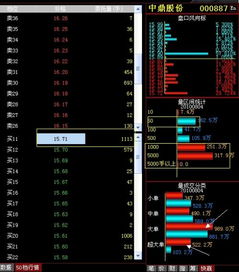股票大单压盘什么意思
Understanding Stock Order Sizes: Big vs Small Orders
In the world of stock trading, the terms "big orders" and "small orders" refer to the size of the trades being executed. Understanding these terms is crucial for investors and traders alike. Let's delve into what they mean and how they can impact the market.
Big Orders
Definition:
Big orders, also known as large orders or block trades, represent transactions involving a significant number of shares or a high total value of a particular stock.Characteristics:

1.
Volume:
Big orders typically involve thousands, if not millions, of shares being bought or sold at once.2.
Impact:
Due to their large size, these orders can have a substantial impact on the stock's price. When a big order is executed, it can influence supply and demand dynamics, causing price movements.3.
Institutional Investors:
Big orders are often associated with institutional investors such as mutual funds, hedge funds, pension funds, and large asset managers. These entities trade in large volumes to meet their investment objectives.4.
Block Trades:
Sometimes, big orders are executed as block trades, which are negotiated offexchange transactions involving large quantities of securities.Effects on Market:
Big orders can signal confidence or pessimism in a particular stock or the overall market sentiment.
They may indicate institutional investors' strategies or movements, which retail investors often watch closely for cues.
Sudden large buy orders can drive up prices, while large sell orders can lead to price declines, affecting shortterm market movements.
Small Orders
Definition:
Small orders refer to trades involving a relatively small number of shares or a low total value of a stock.Characteristics:
1.
Volume:
Small orders typically involve a few hundred shares or less.2.
Retail Investors:
These orders are commonly placed by retail investors, individual traders, or smaller investment firms.3.
Retail Trading Platforms:
With the rise of online trading platforms and apps, small orders have become more prevalent among retail investors who buy and sell stocks in smaller quantities.4.
Day Trading:
Day traders often execute multiple small orders throughout the trading day, aiming to profit from shortterm price fluctuations.Effects on Market:
While individual small orders may not significantly impact stock prices, collectively, they contribute to overall market liquidity.
Small orders can reflect retail investors' sentiment and trading activity, which can sometimes influence market sentiment in the short term.
Highfrequency trading (HFT) algorithms often target small order flows for rapid execution, contributing to market dynamics.
Conclusion
In summary, big orders and small orders represent transactions of different magnitudes in the stock market. Big orders involve large volumes of shares and are typically associated with institutional investors, while small orders involve fewer shares and are commonly placed by retail investors. Both types of orders play essential roles in market dynamics, influencing price movements and liquidity. Understanding the distinctions between big and small orders can help investors better interpret market behavior and make informed trading decisions.
免责声明:本网站部分内容由用户上传,若侵犯您权益,请联系我们,谢谢!联系QQ:2760375052









